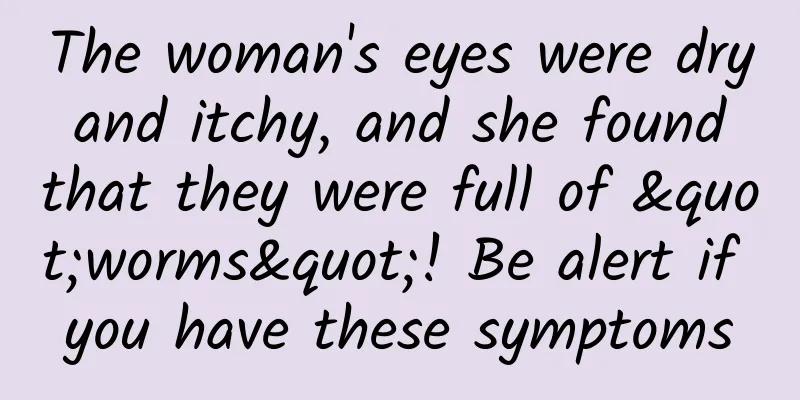The woman's eyes were dry and itchy, and she found that they were full of "worms"! Be alert if you have these symptoms

|
Expert of this article: Li Zongou, Master of Ophthalmology, First Affiliated Hospital of Dalian Medical University This article was reviewed by Lu Jianmin, chief physician, deputy director of the Department of Ophthalmology, the First Affiliated Hospital of Dalian Medical University The eyes are the windows to the soul, but many times, even if their eyes appear dry, itchy, red and swollen... most people still don't take it seriously. Copyright image, no permission to reprint A woman in Shenzhen developed red, dry, itchy eyes and increased white secretions. She thought she had eye fatigue and used anti-fatigue eye drops on her own. As a result, her eyelashes fell off when she washed her face shortly afterwards. After going to the hospital for a check-up, I found out that I had mites in my eyes! News screenshots In recent years, relevant news events are not uncommon. How do eyes get infected with mites? What are the hazards? How to prevent it? Let's find out right away! Why do eyes get infected with mites? There are many kinds of mites. Some mites do not need to parasitize and can exist in the natural environment, while some mites need to parasitize other organisms all the time. Mites that parasitize in the human body and can cause disease include dust mites, chiggers, scabies mites, Demodex mites, etc. The main mite that parasitizes the eyes is the demodex mite. Demodex mites are carriers of many pathogens. Parasitizing in the eyes can cause eye discomfort and cause eye damage. Copyright image, no permission to reprint Demodex mites mainly feed on oil and usually live in areas with high oil secretion, such as the face. Because the eyes are surrounded by the raised nose and brow ridges, unlike other parts of the body that are easy to clean, facial Demodex mites can easily spread to the eyes. How do Demodex mites damage the ocular surface? Eye infection by Demodex may cause discomfort such as itching, redness, swelling, pain, dryness, and foreign body sensation. Different types of Demodex mites cause different damage to the ocular surface. There are two main types of Demodex mites that parasitize the human body: Demodex folliculorum and Demodex sebaceous. Demodex folliculorum Demodex folliculorum mites are large in size and are mainly concentrated in hair follicles. Copyright image, no permission to reprint Demodex follicles usually live in eyelash follicles, feeding on the metabolic products and epithelial cells in the follicles, causing the proliferation, expansion and excessive keratinization of the follicles, producing sleeve-like scales at the root of the eyelashes, causing eyelashes to fall out, inverted eyelashes or disordered eyelashes. Demodex sebaceus Demodex sebaceus is relatively small and is mainly concentrated in the sebaceous glands. Sebaceous Demodex mites live in the sebaceous glands and meibomian glands. The mites themselves and their excrement may block the openings of the meibomian glands, or trigger an inflammatory response that damages the meibomian glands, causing meibomian gland dysfunction, affecting the stability of the tear film, and causing symptoms such as ocular surface discomfort and dry eyes. How to determine if you have Demodex mites in your eyes? Demodex mites cannot be directly observed by the human eye. When a doctor suspects that a patient has Demodex mites, he or she will remove a few eyelashes with more secretions under a slit lamp, smear them on a slide and send them to the laboratory for further examination. The symptoms of itchy eyes, conjunctival congestion, etc. caused by Demodex-related eye diseases are very similar to the symptoms of eye diseases such as allergic conjunctivitis. When the effect is still poor after sufficient doses and sufficient courses of anti-allergic, anti-infective and other drug treatments, and there are high-risk factors such as a humid living environment and unclean household hygiene products, further examination is needed to determine whether you have Demodex-related eye diseases. Copyright image, no permission to reprint In addition, rosacea is also a high-risk factor for ocular Demodex infection. If symptoms similar to Demodex-related eye diseases appear and you also suffer from rosacea, you should be more alert to the possibility that the eye disease may be caused by Demodex infection. What other parasites may infect the eye? There are many types of parasites that can invade the human eye, including protozoa, nematodes, tapeworms, etc. In addition to Demodex mites, common eye damage caused by parasites also includes: Toxoplasmosis Most of them are congenital. Toxoplasma gondii infects the fetus through the placenta. Infection of the embryo in the early stage causes the formation of the optic vesicle and optic pit to be impaired, causing congenital malformations, etc. Toxoplasmosis can also cause damage to other organs in the body, and even cause miscarriage, stillbirth, etc. Toxocara ocularis It is more common in children. When the eggs of Toxocara are accidentally ingested by humans, they hatch into larvae in the intestines, are absorbed through the blood vessels in the intestinal wall, circulate throughout the body with the blood, and when they migrate to the eyes, they induce a local immune response that causes damage to the eyes. Ocular cysticercosis Taenia chaini can parasitize in the human eye or other organs. The cysticercus in the eye mostly parasitizes in the vitreous body, and can also parasitize in the subconjunctiva, eye socket, eyelid, anterior chamber of the eye, etc. After the death of the worm, it will cause a strong pathological reaction, causing eye inflammation and seriously endangering eye health. Conjunctival sucking nematode eye disease The conjunctival sucking nematode mainly parasitizes the eyes of cats, dogs and rabbits, and can also invade the human eye, mainly due to the fruit flies carrying the larvae biting the human eye. Early infection may cause symptoms such as foreign body sensation in the eye, increased eye secretions, photophobia, and pain. If not treated promptly, it may cause secondary glaucoma, bullous corneal degeneration, etc. How to prevent eye parasites? 1. Pay attention to facial cleansing Using anti-mite soap can reduce the probability of Demodex mites infecting the eyes to a certain extent, and when washing your face daily, you should also pay attention to the cleanliness of the eyes. 2. Maintain good indoor ventilation Mites grow best in humid environments. Opening windows frequently for ventilation can keep the room dry and hinder the growth of mites. Copyright image, no permission to reprint 3. Local hot compress Temperatures higher than the human body are not suitable for the growth of mites. Daily hot compresses on the eyes can not only kill mites, but also relieve symptoms such as dry eyes and visual fatigue. 4. Raise awareness of parasitic diseases With the change of people's eating habits and the increasing mobility of population, various new parasitic eye diseases continue to emerge. Therefore, people need to strengthen their understanding and protection of parasitic diseases to reduce and avoid parasitic infections. The watermarked images and cover images in this article are from the copyright gallery, and the image content is not authorized for reprinting |
<<: [Long March 3A series rockets] I am the best at launching satellites!
Recommend
Does water have different levels of light and heavy? Why is heavy water needed to make nuclear weapons?
Does water have light and heavy water? Of course,...
Microsoft's business is increasingly moving towards hardware
Foreign media published an analysis article on Tu...
Antigen test is "positive"! Just because I ate an orange?
Audit expert: Gu Haitong Deputy Chief Physician, ...
Why did trilobites become the "top stream" among ancient creatures?
If rocks are pages of history books recording the...
China Automobile Dealers Association: Analysis of China's automobile imports from January to November 2022
Although the domestic luxury car market is genera...
Why does Inke dare to occupy the top spot on the App Store list?
Crazy live streaming. Whether you are ready or no...
Do you know? How to learn TCP protocol
TCP is currently the de facto foundation of the I...
One set of models to solve the core selling point planning of the brand
The company's new brand is about to enter the...
Tesla's FSD software price will increase to $10,000, and Musk said it will continue to increase in the future
If Tesla's power management technology is the...
Spenser Writing Practice Camp 13th Baidu Cloud Download
Spenser Writing Practice Camp 13th Spenser Writin...
Changge SEO training: Issues that SEO must consider in the early stages of website construction
When it comes to websites, everyone knows and und...
How dazzling is the sun captured by Xihe?
recently Nanjing University Solar Science Data Ce...
These drugs are no longer available and have been recalled! Check if you have any
Notice from the State Drug Administration on 22 b...
First focus image design, click rate increased by at least 50%
How do we strike a balance between “design aesthe...
Without the traffic from NetEase and Alipay, how can ordinary products spread themselves and go viral?
There are unknown secrets behind every screen-swe...









